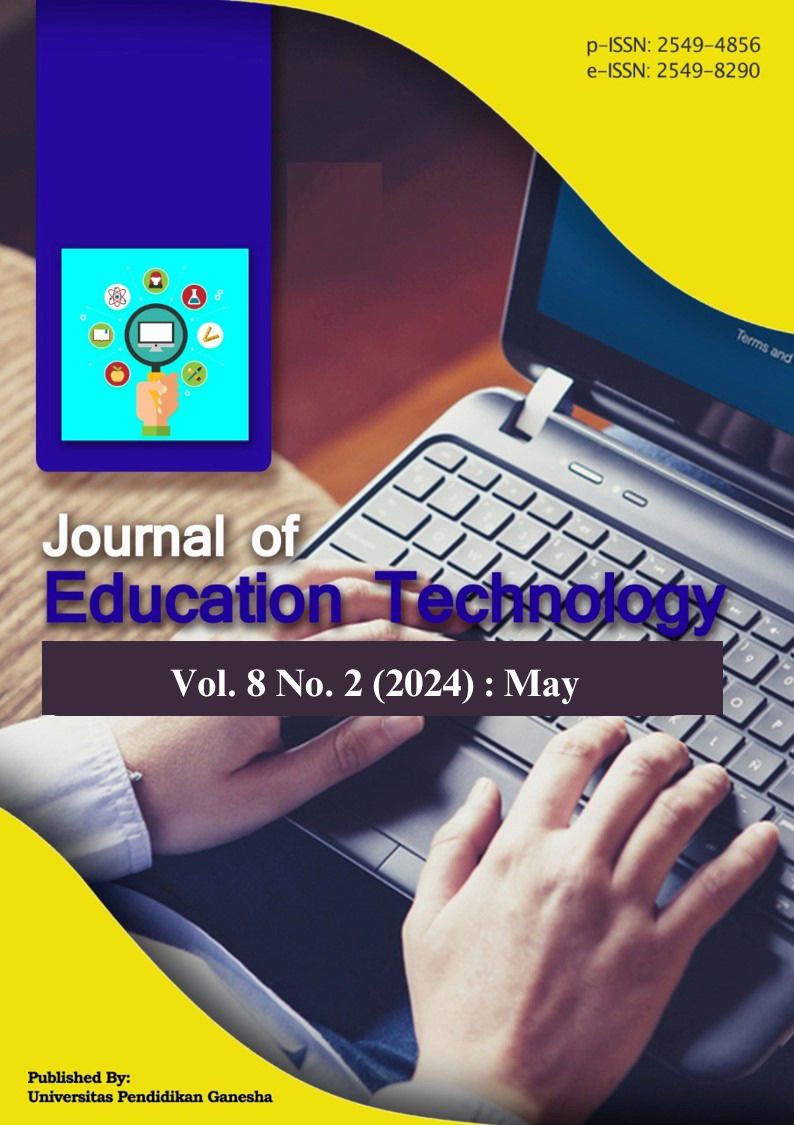The Task-Technology Fit, Technology Induced Engagement, and Technology Induced Motivation on Higher Education Students Learning Performance during COVID-19
DOI:
https://doi.org/10.23887/jet.v8i2.76262Keywords:
Learning Condition, Online Education, Pandemic, Success FactorAbstract
Indonesia was one of the countries affected by the COVID-19 pandemic. This condition encourages the implementation of various policies, including online learning for students to prevent the spread of the virus. Unfortunately, students have difficulties with this learning system. Therefore, this research aims to analyze the condition factors that support learning performance for university students in Indonesia, namely Task-Technology Fit (TTF), Technology-Induced Engagement (TIE), and Technology-Induced Motivation (TIM). Demographic factors, such as location and gender, were also considered in the analysis. Learning success is assessed from the student's Grade Point Average (GPA) during one semester of online lectures. Data collection was carried out using an online questionnaire strategy, which succeeded in reaching 40 valid respondents. The fuzzyset Qualitative Comparative Analysis (fsQCA) method was used to analyse the configuration model for student online learning success. This research succeeded in formulating six combinations of factor conditions that were sufficient to achieve online learning success. Successful online learning includes whether it was related to gender or not, as well as the location of the student's home, and a combination of other factors. Three combinations of conditions that must exist in every successful configuration of student online learning in Indonesia are, urban study location, students having a high TIE, and also a high TIM. The results of this study contribute to lecturers and higher education management regarding the conditions that need to be prepared to support the success of students' online learning.
References
Anwar, S., Salsabila, I., Sofyan, R., & Amna, Z. (2019). Laki-laki atau Perempuan, Siapa yang Lebih Cerdas dalam Proses Belajar? Sebuah Bukti dari Pendekatan Analisis Survival. Jurnal Psikologi, 18(2), 281–296. https://doi.org/10.14710/jp.18.2.281-296.
Assari, S. (2019). Parental Educational Attainment and Academic Performance of American College Students; Blacks’ Diminished Returns. In Journal of health economics and development (Vol. 1, Issue 1, pp. 21–31). https://www.ncbi.nlm.nih.gov/pmc/articles/PMC6673665/.
Budi, A. S., Sumardani, D., Muliyati, D., Bakri, F., Chiu, P.-S., Mutoharoh, M., & Siahaan, M. (2021). Virtual Reality Technology in Physics Learning: Possibility, Trend, and Tools. Jurnal Penelitian & Pengembangan Pendidikan Fisika, 7(1), 23–34. https://doi.org/10.21009/1.07103.
Chen, I. S. (2017). Computer self-efficacy, learning performance, and the mediating role of learning engagement. Computers in Human Behavior, 72, 362–370. https://doi.org/10.1016/j.chb.2017.02.059.
Code, J., Ralph, R., & Forde, K. (2020). Pandemic designs for the future: perspectives of technology education teachers during COVID-19. Information and Learning Science, 121(5–6), 409–421. https://doi.org/10.1108/ILS-04-2020-0112.
Dennis, M. J. (2021). Digital well ‑ being under pandemic conditions : catalysing a theory of online flourishing. Ethics and Information Technology, May 2020. https://doi.org/10.1007/s10676-021-09584-0.
Elçi, A., & Abubakar, A. M. (2021). The Configurational Effects of Task-Technology Fit, Technology-Induced Engagement and Motivation on Learning Performance During Covid-19 Pandemic: An Fsqca Approach. Education and Information Technologies, 19, 1–19. https://doi.org/10.1007/s10639-021-10580-6.
Falck, O., Mang, C., & Woessmann, L. (2018). Virtually no effect? Different uses of classroom computers and their effect on student achievement. Oxford Bulletin of Economics and Statistics, 80(1), 1–38. https://doi.org/10.1111/obes.12192.
Garcia-Cabot, A., Garcia-Lopez, E., Caro-Alvaro, S., Gutierrez-Martinez, J. ., & De-Marcos, L. (2020). Measuring the effects on learning performance and engagement with a gamified social platform in an MSc program. Computer Applications in Engineering Education, 28(1), 207–223. https://doi.org/10.1002/cae.22186.
Heflin, H., Shewmaker, J., & Nguyen, J. (2017). Impact of mobile technology on student attitudes, engagement, and learning. Computers & Education, 107, 91–99. https://doi.org/10.1016/j.compedu.2017.01.006.
Hohne, J. K., Kreb, D., & Kuhneld, S. M. (2021). Measurement properties of completely and end labeled unipolar and bipolar scales in Likert-type questions on income (in)equality. Social Science Research, 97. https://doi.org/10.1016/j.ssresearch.2021.102544.
Hsia, L. H., Huang, I., & Hwang, G. J. (2016). Effects of different online peer-feedback approaches on students’ performance skills, motivation, and self-efficacy in a dance course. Computers & Education, 96, 55–71. https://doi.org/10.1016/j.compedu.2016.02.004.
Irhandayaningsih, A. (2020). Pengukuran Literasi Digital Pada Peserta Pembelajaran Daring Di Masa Pandemi Covid-19. Anuva, 4(2), 231–240. https://demo.dspacedirect.org/bitstream/handle/10673/1975/8073-25123-1-SM.pdf?sequence=1&isAllowed=y.
Jain, V., & Jain, P. (2022). From Industry 4.0 to Education 4.0: acceptance and use of videoconferencing applications in higher education of Oman. Journal of Applied Research in Higher Education, 14(3), 1079–1098. https://doi.org/10.1108/JARHE-10-2020-0378.
Jong Jek Siang, & Santoso, H. B. (2016). Learning Motivation and Study Engagement: Do They Correlate With Gpa? An Evidence From Indonesian University. , https://doi.org/. Researchers World : Journal of Arts, Science and Commerce, 7(1), 111–118. https://doi.org/10.18843/rwjasc/v7i1(1)/12.
Khoa, B. T., Kien, D. T., & Oanh, L. T. K. (2021). Students’ Learning Management System Adoption Intention in COVID-19: An Integration of TPB and TTF Model. 2021 7th International Conference on Education and Technology (ICET), 187–193. https://doi.org/10.1109/ICET53279.2021.9575102.
Khusaini, & Muvera. (2020). Prestasi Belajar dan Karakteristik Orang Tua: Studi Perbandingan Sekolah Menengah Atas Perkotaan-Pedesaan. Jurnal Pendidikan Ekonomi Undiksha, 12(2), 296–310. https://doi.org/10.23887/jjpe.v12i2.28343.
Kibirige, I., & Teffo, W. L. (2014). Actual and Ideal Assessment Practices in South African Natural Sciences Classrooms. International Journal of Educational Sciences, 6(3), 509–519. https://doi.org/10.31901/24566322.2014/06.03.1.
Lin, M.-H., Chen, H., & Liu, K.-S. (2017). A Study of the Effects of Digital Learning on Learning Motivation and Learning Outcome. EURASIA Journal of Mathematics, Science and Technology Education, 13(7). https://doi.org/10.12973/eurasia.2017.00744a.
Mahmud, M. (2019). The use of politeness strategies in the classroom context by English university students. Indonesian Journal of Applied Linguistics, 8(3), 597–606. https://doi.org/10.17509/ijal.v8i3.15258.
Mandasari, B., Rido, A., & Kuswoyo, H. (2022). Using Zoom Meeting Platform As a Synchronous Online Learning Tool in Efl Classroom At Indonesia Tertiary Level: a Literature Review. Proceedings of the 19th International Conference on Cognition and Exploratory Learning in the Digital Age, CELDA 2022, Celda, 291–294. https://doi.org/10.33965/celda2022_202207c037.
Maziyah, N., Rais, R., & Kiswoyo, K. (2022). Analisis Nilai Spiritual dalam Pembentukan Karakter pada Buku Cerita Rakyat Karya Wirodarsono. Indonesian Values and Character Education Journal, 2(1), 11. https://doi.org/10.23887/ivcej.v2i1.17924.
Mejia, C. (2020). Using Voicethread as a discussion platform to enhance student engagement in a hospitality management online course. Journal of Hospitality, Leisure, Sport & Tourism Education, 26(100236). https://doi.org/10.1016/j.jhlste.2019.100236
Mulyani, Fidyati, Suryani, Suri, M., & Halimatussakdiah. (2021). University students’ perceptions through e-learning implementation during covid-19 pandemic: Positive or negative features dominate? Studies in English Language and Education, 8(1), 197–211. https://doi.org/10.24815/siele.v8i1.17628.
Niehaus, K., Rudasill, K. M., & Adelson, J. L. (2012). Self-Efficacy, Intrinsic Motivation, and Academic Outcomes Among Latino Middle School Students Participating in an After-School Program. Hispanic Journal of Behavioral Sciences, 34(1), 118–136. https://doi.org/10.1177/0739986311424275
Reidelbach, M., Zimmer, C., Meunier, B., Rich, P. R., & Sharma, V. (2021). Electron Transfer Coupled to Conformational Dynamics in Cell Respiration. Frontiers in Molecular Biosciences, 8, 711436. https://doi.org/10.3389/fmolb.2021.711436.
Sari, D. I., Zayyadi, M., Osman, S., Milawati, M., & Kurniati, D. (2022). The Application of Synchronous and Asynchronous Learning using E-learning on Elementary Linear Algebra. Jurnal Didaktik Matematika, 9(1), 22–38. https://doi.org/10.24815/jdm.v9i1.24759.
Sarid, M., Meltzer, Y., & Raveh, M. (2020). Academic Achievements of College Graduates With Learning Disabilities Vis-a-Vis Admission Criteria and Academic Support. Journal of Learning Disabilities, 53(1), 60–74. https://doi.org/10.1177/0022219419884064.
Setiawardhani, R. T. (2013). Pembelajaran elektronik (e-learning) dan internet dalam rangka mengoptimalkan kreativitas belajar siswa. Jurnal Ilmiah Pendidikan Ekonomi Unswagati, 1(2), 82–96. http://fkip-unswagati.ac.id/ejournal/index.php/edunomic/article/download/21/20.
Sun, J. C. Y. (2014). Influence of polling technologies on student engagement: An analysis of student motivation, academic performance, and brainwave data. Computers & Education, 72, 80–89. https://doi.org/10.1016/j.compedu.2013.10.010.
Syahruddin, S., Yaakob, M. F. M., Rasyad, A., Widodo, A. W., Sukendro, S., Suwardi, S., Lani, A., Sari, L. P., Mansur, M., Razali, R., & Syam, A. (2021). Students’ acceptance to distance learning during Covid-19: the role of geographical areas among Indonesian sports science students. Heliyon, 7(9), e08043.1-9. https://doi.org/10.1016/j.heliyon.2021.e08043.
Tran, T., Phan, H. A., Le, H. Van, & Nguyen, H. T. (2020). ICT integration in developing competence for pre-service mathematics teachers: A case study from six universities in Vietnam. International Journal of Emerging Technologies in Learning, 15(14), 19–34. https://doi.org/10.3991/ijet.v15i14.14015.
Ugwu, O. (2019). How students of different backgrounds use strategies to strengthen college enrolment applications. Science Daily Journal, 16(7), 22–67. http://sjifactor.com/passport.php?id=21363.
Vanduhe, V. Z., Nat, M., & Hasan, H. F. (2020). Continuance Intentions to Use Gamification for Training in Higher Education: Integrating the Technology Acceptance Model (TAM), Social Motivation, and Task Technology Fit (TTF). IEEE Access, 8, 21473–21484. https://doi.org/10.1109/ACCESS.2020.2966179.
Vidić, T. (2021). Students’ School Satisfaction: The Role of Classroom Climate, Self-efficacy, and Engagement. International Journal of Cognitive Research in Science, Engineering and Education (IJCRSEE), 9(3), 347–357. https://www.ceeol.com/search/article-detail?id=1002059
Wang, Y., & Liu, Q. (2020). Effects of online teaching presence on students’ interactions and collaborative knowledge construction. Journal of Computer Assisted Learning, 36(3), 370–382. https://doi.org/10.1111/jcal.12408.
Wu, J. Y., & Nian, M. W. (2021). The dynamics of an online learning community in a hybrid statistics classroom over time: Implications for the question-oriented problem-solving course design with the social network analysis approach. Computers & Education, 166, 104120. https://doi.org/10.1016/j.compedu.2020.104120.
Yogendra, N., & Andrew, A. (2017). A Study On The Factors Influencing On Grade Point Average (GPA) With Special Reference To Third Year Commerce And Management Students Of Eastern University, Sri Lanka. Journal for Studies in Management and Planning, 3, 409–425. https://www.researchgate.net/profile/Anthony-Andrew-2/publication/319645230.
Yüce, A., Abubakar, A. M., & İlkan, M. (2019). Intelligent tutoring systems and learning performance: Applying task-technology fit and IS success model. Online Information Review, 43(4), 600–616. https://doi.org/10.1108/OIR-11-2017-0340.
Yulianti, K., Denessen, E., & Droop, M. (2019). Indonesian Parents’ Involvement in Their Children’s Education: A Study in Elementary Schools in Urban and Rural Java, Indonesia. School Community Journal, 29(1), 253–278. https://repository.ubn.ru.nl/bitstream/handle/2066/204353/204353.pdf.
Zhang, Y. G., & Dang, M. Y. (2020). Understanding essential factors in influencing technology-supported learning: A model toward blended learning success. Journal of Information Technology Education
Downloads
Published
How to Cite
Issue
Section
License
Copyright (c) 2024 Retno Wulan Damayanti, Arissa Dwi Pangestu, Ayu Setiawati, Hani Aninda Intan Permatasari, Muhammad Raihan Syaifudin, Nisa Aqilla Ellenahaya Entifar

This work is licensed under a Creative Commons Attribution-ShareAlike 4.0 International License.
Authors who publish with the Journal of Education Technology agree to the following terms:
- Authors retain copyright and grant the journal the right of first publication with the work simultaneously licensed under a Creative Commons Attribution License (CC BY-SA 4.0) that allows others to share the work with an acknowledgment of the work's authorship and initial publication in this journal.
- Authors are able to enter into separate, additional contractual arrangements for the non-exclusive distribution of the journal's published version of the work (e.g., post it to an institutional repository or publish it in a book), with an acknowledgment of its initial publication in this journal.
- Authors are permitted and encouraged to post their work online (e.g., in institutional repositories or on their website) prior to and during the submission process, as it can lead to productive exchanges, as well as earlier and greater citation of published work. (See The Effect of Open Access)


















